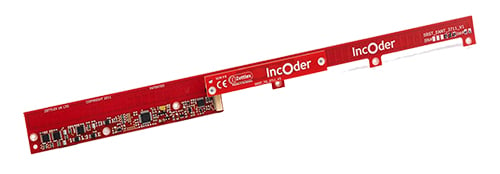Absolute encoders measure absolute or true angular position. This contrasts with incremental encoders which measure the change in angular position. The test as to whether an encoder is absolute or incremental is what happens at power up. If the encoder has to move or go through some ‘wake and shake’ process to determine its position then it is incremental. If it outputs its true position without motion then it is absolute.
Absolute encoders typically output either a digital data stream, such as serial synchronous interface (SSI) or an analogue signal such as 0-10V or 4-20mA. Incremental encoders typically output pulses which are often described as A/B pulse or ‘A quad B’ encoders.
Traditionally, the cost of an absolute encoder is more than a comparable incremental encoder. Whilst this remains true, the difference is diminishing as the use of absolute encoders is increasingly preferred over incremental encoders.
Optical encoders can offer the highest levels of measurement performance. They are not well suited to harsh environments with extreme temperatures, shock, vibration, fluids or foreign matter. In more aggressive environments, an increasingly popular choice for absolute encoding is the inductive encoder or IncOder.
Absolute Encoders vs Incremental Encoders
The distinguishing feature of an incremental encoder is that it reports a change in angle. When an incremental encoder is powered up, it does not report its angular position until it is provided with a reference point from which it measures.
When an absolute encoder is powered up it will report its angle without the need for any reference information or movement.
For incremental encoders, with A/B pulse style outputs, resolution is specified as 4x the number of pulses per rev since there are 2 edges to be counted per each pulse in the A stream and 2 edges on each B stream pulse. For absolute encoders, resolution is usually stated as the number of measurement bits per revolution – for example 19 bits or 524,288cpr.
A/B is also referred to as A quad B where quad relates to 90° phase shift. A controller detects transitions on the edge of each square wave which effectively increases the encoder resolution by a factor of 4.
You can read more in our Technical Paper – Absolute vs incremental encoders.

Types of Zettlex Absolute Encoder
Absolute Rotary Encoders
The most common format for Zettlex sensors is a rotary format. The form factor of a rotary encoder enables integration into small spaces and is particularly suited for use in direct drive frameless rotary motor control applications. This is ideal for requirements where either a larger shaft must be passed through the centre of the sensor, such as in robotic joints, and extreme levels of accuracy are required.
Zettlex technology is optimal for rotary absolute encoders and IncOder is our standard rotary inductive encoder product line.
Absolute linear encoders
Zettlex linear encoders are non-contact absolute linear position measuring devices that utilize a unique inductive technique. Each linear encoder is comprised of two main components – a Target and a Stator. The Stator is longer than the Target, is powered with an electrical supply and can be moving or stationary.


Applications for Absolute Encoders
Absolute encoders are used in a wide range of applications that require monitoring or control, or both, of mechanical systems. These applications include;
- Surgical robotics
- Diagnostic imaging
- Radiation therapy
- Satellite communications
- UAVs and ROVs
- Industrial robotics
- Photonics
- Microelectronics
- Scientific











